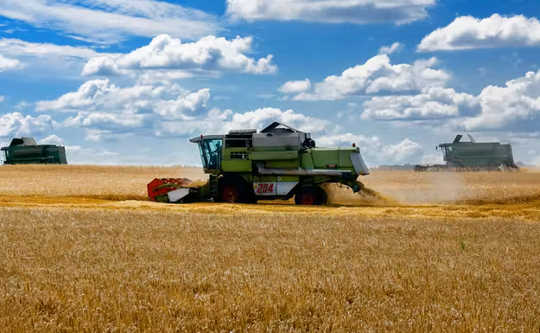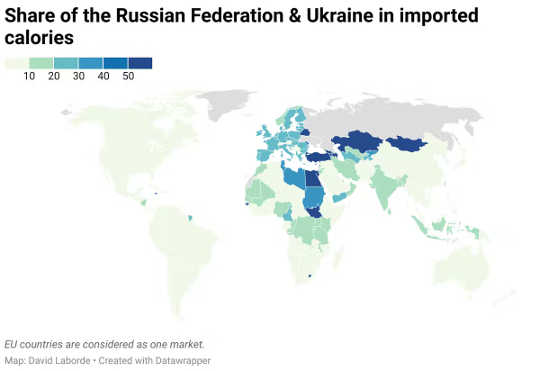
The war in Ukraine will continue to push up food prices as the supply from the ‘Breadbasket of Europe’ is cut in the short term and, possibly, the long term. (Shutterstock)
Even before the Russian army crossed into Ukraine, food prices had been on the rise for the past year. But the world has seen large jumps in the cost of food over the the last two months.
Globally, food is 20 per cent more expensive now than it was a year ago, with prices rising four per cent since January this year. In Canada, the annual food inflation rate hit 6.5 per cent in January, the highest in more than a decade.
A variety of factors have caused these price increases, including rising transportation costs, supply chain disruptions and rising commodity prices, such as corn and wheat.
The war in Ukraine will continue to push up food prices as the supply from the “Breadbasket of Europe” is cut in the short term and, possibly, the long term depending on how the conflict plays out.
War and wheat prices
Ukraine and Russia represent around 10 per cent and 20 per cent, respectively, of global wheat production, and nearly 30 per cent of all wheat exports come from these two countries. Most of this wheat is imported by countries in the Middle East and North Africa.
For example, Lebanon and Tunisia, two countries with vulnerable economies, import more than half of their wheat from Ukraine. Consequently, production from Ukraine, or lack thereof, influences global food security. While Ukraine has been a consistent supplier in the past, we’ve seen global shortages impact food security before.

Proportion of calories from food that are imported from Russia and Ukraine. (David Laborde)
The wheat export supply chains from Ukraine have been disrupted by the conflict. Port facilities in Ukraine have suspended commercial operations, preventing the outflow of the wheat crop harvested in 2021.
While the 2022 wheat crop was planted last fall, other crops need to be planted soon. Final production for all crops in Ukraine depends on farmers being in their fields, not fighting a war, to fertilize, harvest and move the crop, if the supply chain is sturdy enough.
Since Russia invaded the Ukraine, concerns about supply disruptions have pushed up wheat prices on the Chicago Board of Trade by over 50 per cent to nearly US$13 per bushel. Prices rose by the maximum possible allowed by the board for the first five trading days of March — an unprecedented increase.
Domestic and international impacts
Higher wheat prices will translate into higher food prices for all. But the impact will depend on the farmer share of their food dollar, and the percentage of an individual’s income spent on food.
A significant increase in the price of wheat won’t mean an equally large increase in the price of bread in Canada and the United States. This is because the average farmer’s share for every dollar spent on a loaf of bread is four cents (four per cent). For flour, which is less processed than bread, the farmer’s share is 19 cents (19 per cent).
Overall, the farmer share of the food dollar in the U.S. is approximately 15 per cent, and it’s slightly higher in Canada. The greater degree of value added to the product beyond the farm gate, the lower the farm share.
In contrast, there is a strong correlation between wheat price and bread price in developing countries, where the farmer share of the food dollar can be close to 50 per cent. Wheat price increases will have a significant impact on the price paid for wheat-based products.
Income matters too
The relative effect of any food price increase will also depend on the share of income spent on food. This share declines with the wealth of the nation or consumer, as summarized by Engel’s Law.
The average Canadian household spends less that 10 per cent of its income on food. An increase in the cost of food can be absorbed, although it will lower the amount of disposable income for other goods and services. Food price increases take away income for things like leisure activities.
In less-developed countries — and for poorer households domestically — the share of income spent on food can be above 40 per cent. For example, Lebanon and Yemen will need to import wheat at a higher cost than what they were paying for wheat from Ukraine, in a tight market. The large price increase will force a corresponding large increase in the price of bread, given the higher farmer share of the food dollar.
The financial consequences for those consumers will be large given the relatively high percentage of income spent on food, and bread in particular. With less room to divert income from other expenditures, food security may be compromised. Low-income Canadians who are also facing rent increases will be similarly squeezed.
Another factor influencing the distributional impact of an increase in wheat price is whether the household or region is a wheat producer or consumer. Developing countries with a large share of poor households in urban areas are especially vulnerable to the financial hit of an increase in wheat price.
A decade ago, when crop prices last rose significantly, food riots broke out in countries with a high concentration of poor consumers in urban areas, including Egypt, Mexico and Pakistan. In contrast, other developing countries with a high proportion of small farms can sell some of their crop into the market. These farmers benefit from a commodity price increase and the benefits also accrue to the broader economy as these small farmers have a bit more money to spend.
The compounding factor of energy prices
The Russian invasion of Ukraine has also shocked energy markets. Russia produces 23 per cent of the world’s natural gas, and about 40 per cent of the European Union’s natural gas comes from Russia. Russia is also a major exporter of oil.
Sanctions have helped pushed up Brent crude oil prices by more than 60 per cent since the beginning of the year, although they are not the only reason the price of oil is high.
In developed countries, including Canada, the increase in energy prices is the major driver of food inflation. The food supply chain from the production at the farm level to the transportation, processing, storing and eventually selling at retail, relies heavily on energy. In developing countries, the increase in energy prices does not have the same relative impact but it will further exacerbate the increase in food prices.
The impacts felt most by the most vulnerable
The Russian invasion of Ukraine has set off a series of direct and indirect supply shocks to commodity markets. The impacts of these shocks will vary with the degree of reliance on wheat and energy from these countries.
The most vulnerable are net importing food countries that are dependent on Ukraine. The risk to global food security in these regions can be mitigated to a degree by allowing food trade to continue. One means is to avoid sanctioning Russian food exports, and the other as advocated by G7 agricultural ministers, is for other countries to not use export bans that would restrict movement of food out of their country.
However, the only way to ultimately reduce the impact is stop the conflict in Ukraine and get wheat flowing again.![]()
About The Author
Alfons Weersink, Professor, Dept of Food, Agricultural and Resource Economics, University of Guelph and Michael von Massow, Associate Professor, Food Economics, University of Guelph
This article is republished from The Conversation under a Creative Commons license. Read the original article.
Recommended books:
Capital in the Twenty-First Century
by Thomas Piketty. (Translated by Arthur Goldhammer)
 In Capital in the Twenty-First Century, Thomas Piketty analyzes a unique collection of data from twenty countries, ranging as far back as the eighteenth century, to uncover key economic and social patterns. But economic trends are not acts of God. Political action has curbed dangerous inequalities in the past, says Thomas Piketty, and may do so again. A work of extraordinary ambition, originality, and rigor, Capital in the Twenty-First Century reorients our understanding of economic history and confronts us with sobering lessons for today. His findings will transform debate and set the agenda for the next generation of thought about wealth and inequality.
In Capital in the Twenty-First Century, Thomas Piketty analyzes a unique collection of data from twenty countries, ranging as far back as the eighteenth century, to uncover key economic and social patterns. But economic trends are not acts of God. Political action has curbed dangerous inequalities in the past, says Thomas Piketty, and may do so again. A work of extraordinary ambition, originality, and rigor, Capital in the Twenty-First Century reorients our understanding of economic history and confronts us with sobering lessons for today. His findings will transform debate and set the agenda for the next generation of thought about wealth and inequality.
Click here for more info and/or to order this book on Amazon.
Nature's Fortune: How Business and Society Thrive by Investing in Nature
by Mark R. Tercek and Jonathan S. Adams.
 What is nature worth? The answer to this question—which traditionally has been framed in environmental terms—is revolutionizing the way we do business. In Nature’s Fortune, Mark Tercek, CEO of The Nature Conservancy and former investment banker, and science writer Jonathan Adams argue that nature is not only the foundation of human well-being, but also the smartest commercial investment any business or government can make. The forests, floodplains, and oyster reefs often seen simply as raw materials or as obstacles to be cleared in the name of progress are, in fact as important to our future prosperity as technology or law or business innovation. Nature’s Fortune offers an essential guide to the world’s economic—and environmental—well-being.
What is nature worth? The answer to this question—which traditionally has been framed in environmental terms—is revolutionizing the way we do business. In Nature’s Fortune, Mark Tercek, CEO of The Nature Conservancy and former investment banker, and science writer Jonathan Adams argue that nature is not only the foundation of human well-being, but also the smartest commercial investment any business or government can make. The forests, floodplains, and oyster reefs often seen simply as raw materials or as obstacles to be cleared in the name of progress are, in fact as important to our future prosperity as technology or law or business innovation. Nature’s Fortune offers an essential guide to the world’s economic—and environmental—well-being.
Click here for more info and/or to order this book on Amazon.
Beyond Outrage: What has gone wrong with our economy and our democracy, and how to fix it -- by Robert B. Reich
 In this timely book, Robert B. Reich argues that nothing good happens in Washington unless citizens are energized and organized to make sure Washington acts in the public good. The first step is to see the big picture. Beyond Outrage connects the dots, showing why the increasing share of income and wealth going to the top has hobbled jobs and growth for everyone else, undermining our democracy; caused Americans to become increasingly cynical about public life; and turned many Americans against one another. He also explains why the proposals of the “regressive right” are dead wrong and provides a clear roadmap of what must be done instead. Here’s a plan for action for everyone who cares about the future of America.
In this timely book, Robert B. Reich argues that nothing good happens in Washington unless citizens are energized and organized to make sure Washington acts in the public good. The first step is to see the big picture. Beyond Outrage connects the dots, showing why the increasing share of income and wealth going to the top has hobbled jobs and growth for everyone else, undermining our democracy; caused Americans to become increasingly cynical about public life; and turned many Americans against one another. He also explains why the proposals of the “regressive right” are dead wrong and provides a clear roadmap of what must be done instead. Here’s a plan for action for everyone who cares about the future of America.
Click here for more info or to order this book on Amazon.
This Changes Everything: Occupy Wall Street and the 99% Movement
by Sarah van Gelder and staff of YES! Magazine.
 This Changes Everything shows how the Occupy movement is shifting the way people view themselves and the world, the kind of society they believe is possible, and their own involvement in creating a society that works for the 99% rather than just the 1%. Attempts to pigeonhole this decentralized, fast-evolving movement have led to confusion and misperception. In this volume, the editors of YES! Magazine bring together voices from inside and outside the protests to convey the issues, possibilities, and personalities associated with the Occupy Wall Street movement. This book features contributions from Naomi Klein, David Korten, Rebecca Solnit, Ralph Nader, and others, as well as Occupy activists who were there from the beginning.
This Changes Everything shows how the Occupy movement is shifting the way people view themselves and the world, the kind of society they believe is possible, and their own involvement in creating a society that works for the 99% rather than just the 1%. Attempts to pigeonhole this decentralized, fast-evolving movement have led to confusion and misperception. In this volume, the editors of YES! Magazine bring together voices from inside and outside the protests to convey the issues, possibilities, and personalities associated with the Occupy Wall Street movement. This book features contributions from Naomi Klein, David Korten, Rebecca Solnit, Ralph Nader, and others, as well as Occupy activists who were there from the beginning.
Click here for more info and/or to order this book on Amazon.
























